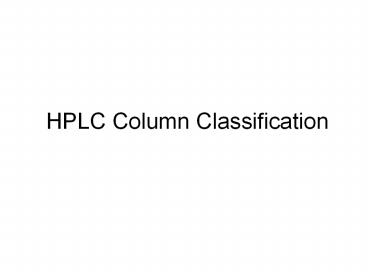HPLC Column Classification - PowerPoint PPT Presentation
1 / 20
Title:
HPLC Column Classification
Description:
1. Hydrophobicity (capacity factor of ethylbenzene) 2. Chelation (tailing factor of quinizarin) ... Column hydrophobicity (H) - increase in total carbon H increase ... – PowerPoint PPT presentation
Number of Views:1829
Avg rating:3.0/5.0
Title: HPLC Column Classification
1
HPLC Column Classification
2
- Introduction
- 1978 USP XIX Fourth supplement L1 designation
for C18 column - 1980 USP XX 7 columns were classified
- -Classified HPLC column to 56 descriptions
- More than 220 columns currently available in the
worldwide market can be classified as L1 - How to select column for a particular application
?
3
- USP Approach
- Use NIST Standard Reference Material (SRM) 870 to
evaluate C18 column - -SRM 870 the mixture of 5 organic compounds in
methanol ( uracil, toluene, - ethylbenzene, quinizarin and amitriptyline)
- The components in SRM 870 are provide a board
characterization of - column performance in a single, simple test
4
Parameters used in the characterization of the
columns 1. Hydrophobicity (capacity factor of
ethylbenzene) 2. Chelation (tailing factor of
quinizarin) 3. Activity toward bases (silanol
activity, capacity factor factor and tailing
factor of amitriptyline) 4. Shape selectivity
(bonding density)
5
Chromatographic condition Mobile phase 80
methanol and 20 phosphate buffer pH 7.0 Column
temperature 23C 1C Chromatographic
properties - Peak width (efficiency
theoretical plates) - Peak symmetry (As) -
Absolute retention (k) - Selectivity factor
(relative retention (k1/ k2)
6
- Uracil
- Indicator of the void volume (unretained volume)
- To calculate the retention factor
- Toluene/Ethylbenzene
- The selective factor ?E/T kethylbenzene/
ktoluene Characterize differences among C8
and C18 column - - Marker for calculation of column efficiency
(theoretical plates, N)
7
- Quinizarin
- Metal chelating agent
- Indicative of the present or absence of metals
in HPLC system - Low activity toward chelating reagent
symmetric peak shape - High activity toward chelating reagent
tailing, asymmetric peak shape - Embedded polar functional groups column,
quinizarin elute last with good - peak symmetry
8
- Amitriptyline
- Basic cpd. (pKa 9.4)
- High silanol activity elution of
organic bases with severe -
peak tailing
9
- Development of SRM870 with 41 commercial C18
columns - - No two columns exhibit identical retention
behavior, similarities do - exist among several columns
- k of ethylbenzene 0.2-2.8
- ?E/T 1.26-1.45
- Retention of quinizarin, k 1- 23.6 (peak
asymmetry 1.1-5.7) - - Retention of amitriptyline, k 1.4-72.9 (peak
asymmetry 1.0-11)
10
- PQRI initiative
- The Snyder/Dolan column test
- A series of standard mixtures
- mixture 1 thiourea, amitriptyline,
4-butylbenzoic acid - mixture 1a N,N-diethylacetamide,
5-phenyl-1-pentanol, - ethylbenzene
- mixture 2 N,N-dimethylacetamide,5,5-diphenylhyd
antoin, - toluene
- mixture 2a nortriptyline, acetophenone,
mefenamic acid - mixture 3 p-nitrophenol, anisole,
4-hexylaniline - mixture 3a cis/trans chalcone, benzonitrile
- mixture 4 berberine
11
Chromatographic condition Mobile phase
50acetonitrile/buffer pH 2.8 and 7.0 Column
temperature 35C
12
Column selectivity parameters - relative
retention (kEB) - hydrophobicity (H) - steric
interaction (S) - hydrogen-bond acidity (A) -
hydrogen-bond basicity (B) - relative silanol
ionization or caion-exchange capacity (C)
13
- Column hydrophobicity (H)
- - increase in total carbon H
increase - Compression of the ends of the alkyl chains in
small-pore packing - H increase
- - Minor effect on column selectivity
14
- Column steric interaction (S)
- Crowded bonded phase S increase
- Increased chain length / concentration of bonded
phase - S increase
- - Compression of the ends of the alkyl chains in
small-pore packing - S increase
- Significant effect on column selectivity,
especially for molecules - of different shape
15
- Column hydrogen-bond acidity (A)
- non-ionized silanols increases with column
acidity - More acidic column, greater values of A
- For end-capped column, the number of accessible
and unreacted silanols decrease - A
decrease - non-ionized basic molecules (amines, amides,
aliphatic derivatives) - have significant A on column selectivity
16
- Column hydrogen-bond basicity (B)
- Various function gr. Within the bonded phase
B increase - - Columns with larger values of B preferentially
retain acidic cpd.
17
- Silanol ionization (C)
- Results in a negative charge on column, attract
ionized bases and repel ionized acids - pH oh mobile phase increase C
increase - end-capping, decrease access to ionized silanols
- large decrease in C
18
Equivalent columns similar values of the six
column selectivity parameters
19
- Column comparison function, Fs
- Fs 12.5(H2-H1)2 100(S2-S1)2
30(A2-A1)2 - 143(B2-B1)2 83(C2-C1)21/2
- Fs lt 3 equivalent selectivity and band spacing
- Fs gt 3 equivalent separation may still be
achieved but less certain - - No acids or bases in sample , ignore term C2-C1
- a much smaller value of Fs
- No carboxylic acid in sample, ignore term B2-B1
- reduce in value of Fs
20
- Conclusion
- USP approach
- Provides column performance characterization
(theoretical plate count, good peak symmetry,
etc.) - -produces five data points to describe the column
- PQRI approach
- -provides selectivity characterization (relative
retention times) - -produces a list of suitable columns ordered by
the Fs factor































